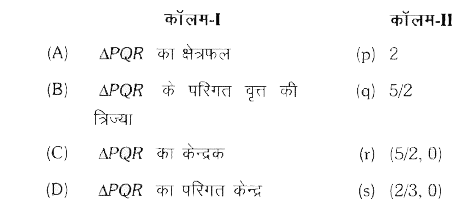दिया है n (U) = 20, n (A) = 12, n (B) = 9, n(A∩B) = 4 , जहाँ U समष्टीय समुच्चय है। यदि A तथा B, U के उपसमुच्चय है, तब n(A∪B)c =
17
9
11
3
The correct Answer is:D
Step by step video, text & image solution for दिया है n (U) = 20, n (A) = 12, n (B) = 9, n (A cap B) = 4 , जहाँ U समष्टीय समुच्चय है। यदि A तथा B, U के उपसमुच्चय है, तब n (A cup B)^(c) = by Maths experts to help you in doubts & scoring excellent marks in Class 12 exams.
Updated on:21/07/2023Topper's Solved these Questions
- समुच्चय सिद्धान्त तथा सम्बन्ध BOOK - ERRORLESS HINDICHAPTER - समुच्चय सिद्धान्त तथा सम्बन्ध EXERCISE - SOLVED MULTIPLE CHOICE QUESTIONS (सम्बन्ध)
31 Videos
- समुच्चय सिद्धान्त तथा सम्बन्ध BOOK - ERRORLESS HINDICHAPTER - समुच्चय सिद्धान्त तथा सम्बन्ध EXERCISE - Exercise
46 Videos
- समुच्चय सिद्धान्त तथा सम्बन्ध BOOK - ERRORLESS HINDICHAPTER - समुच्चय सिद्धान्त तथा सम्बन्ध EXERCISE - JEE Advanced (Reasoning type questions)
3 Videos
- समकोणीय कार्तीय निर्देशांक BOOK - ERRORLESS HINDICHAPTER - समकोणीय कार्तीय निर्देशांक EXERCISE - JEE ADVANCED (MORE THAN ONE CORRECT ANSWERS) (MATRIX MATCH TYPE QUESTIONS)
1 Videos
- सम्मिश्र संख्यायेंBOOK - ERRORLESS HINDICHAPTER - सम्मिश्र संख्यायेंEXERCISE - Jee Advanced (Integer)
9 Videos
Similar Questions
माना X = {1,2,3,4,5} तथा Y = {1,3,5,7,9}, तब निम्न में से कौन सा X और Y में सम्बन्ध है
View SolutionA, B, C तीन समुच्चय इस प्रकार है कि a=B∩C और B=C∩A, तब
View Solutionमाना R वास्तविक संख्याओं का समुच्चय है
कथन-1 : A={(x,y)∈R×R:y−x एक पूर्णांक है} R पर एक तुल्यता संबंध है |
कथन-2 : B={(x,y)∈R×R:x=αy किसी परिमेय संख्या α के लिए} R पर एक तुल्यता संबंध है |
View Solutionपरवलय y2=4x पर स्थित बिन्दुओं P,Q तथा R से अभिलंब खींचे जाते है जो कि (3,0) पर प्रतिच्छेद करते है। तब, कॉलम I में दी गयी स्थितियों/व्यंजकों का कॉलम ॥ में दिए गए वक्तव्यों से सुमेल करें:

View Solutionमान लीजिए कि z कोई सम्मिश्र संख्या है जिसके लिये |z−3−2i|≤2 सत्य है, तो |2z-6+5i| का न्यूनतम मान है
View SolutionThere are 600 elements in universal set U. If A and B are subsets of U and n(A)=300,n(B)=250 and n(A∩B)=50, then n(A'∩B') is :
View SolutionGiven n(U) = 20, n(A) = 12, n(B) = 9, n(A∩B) = 4, where U is the universal set, A and B are subsets of U, then n((A∪B)') equals
View Solution(i)If n(A)=25, n(B)=40, n(A∪B)=50andn(B')=25, find n(A∩B)andn(U).
(ii) If n(A)=300,n(A∪B)=500,n(A∩B)=50andn(B')=350, find n(B)andn(U).
View SolutionIf n(U)=70,n(A)=25,n(B)=30,n(A∩B)=5, then n(A∪B)' is..........
View SolutionConsider n(U)=20 , n (A) =12, n(B)=9, n(A ∩ B) =4, where U is the universal set, A and B are subsets of U, then n((A∪B)c)=
View SolutionGiven n(U)=20, n(A)=12, n(B)=10, n(A∩B)=4 where U is the universal set, A and B are subsets of U then n( (A∪B)c)=
View SolutionGiven n(U)=20, n(A)=12, n(B)=9, n(A∩B)=4, where U is the universal set, A and B are subsets of U, then n[(A∪B)']=
View SolutionIf n(U) = 700, n(A) = 200, n(B) = 240, n(A∩B) = 100, then n(A' ∪ B') equals
View SolutionIf n(U) = 25, n(A) = 12, n(B)=11, n(A∩B)=4, where U is the universal set, A and B are sub-sets of U, then n((A∪B)') is equal to
View SolutionFor sets A and B , n(A) = 20 , n(B) = 30 , n (A∪B)=40,n(A∩B)=10andn(U)=100 then n(A'∩B')=60.
View Solution
